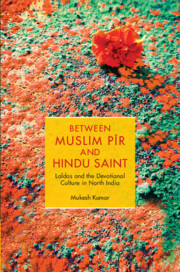Book contents
- Frontmatter
- Dedication
- Contents
- List of Figures, Maps and Tables
- Acknowledgements
- List of Abbreviations
- A Note on Transliteration
- Maps
- 1 The Spectre of Binaries
- 2 Laldas and Religious Duality of Pīr and Sant
- 3 The Laldas Shrines and Inter-religious Disputes
- 4 A Fait Accompli: The Complete Hinduisation of the Laldas Order
- 5 Religious Reform and Shared Shrines
- 6 Concealment and Secrecy: Hidden in Plain Sight
- 7 Poetic Response to Religious Puritanism
- 8 An Ephemeral Line in the Sand
- Appendices
- Glossary
- Bibliography
- Index
3 - The Laldas Shrines and Inter-religious Disputes
Published online by Cambridge University Press: 30 April 2024
- Frontmatter
- Dedication
- Contents
- List of Figures, Maps and Tables
- Acknowledgements
- List of Abbreviations
- A Note on Transliteration
- Maps
- 1 The Spectre of Binaries
- 2 Laldas and Religious Duality of Pīr and Sant
- 3 The Laldas Shrines and Inter-religious Disputes
- 4 A Fait Accompli: The Complete Hinduisation of the Laldas Order
- 5 Religious Reform and Shared Shrines
- 6 Concealment and Secrecy: Hidden in Plain Sight
- 7 Poetic Response to Religious Puritanism
- 8 An Ephemeral Line in the Sand
- Appendices
- Glossary
- Bibliography
- Index
Summary
Sherpur, nine miles north-east of Ramgarh, is remarkable for the tomb of Laldas, whose body is said to have come to Sherpur from the neighbouring Bharatpur village of Nagla, six months after death and burial. The tomb is a very substantial masonry building 100 feet long, with a high dome, and walls 5 feet thick. The interior is vaulted and low. The body of Laldas lies in a crypt several feet below the surface. Many other members of Laldas's family were interred at Sherpur. (Powlett 1878: 153)
When I began my fieldwork, I visited the Laldas shrine in Sherpur under the impression that it was a temple. However, upon approaching the structure, I noticed that its dome was somewhat atypical and gave it the appearance of a tomb rather than a temple. Unlike north Indian temples, which typically feature tower-like canopies, the shrine of Laldas had the usual architectural style of an Indo-Islamic structure (as shown in Figure 3.1). Additionally, there were a number of saffron-coloured flags hoisted at the top of the domes. As I explored the site, it became clear that this building was not a conventional Hindu temple, even though there were many Hindu symbols present.
A massive hoarding with the slogan pujaniya sant śrī 108 bābā śri lāldās mahārāj jī (The holy saint śri 108 Baba Laldas maharaj), a common epithet for a Hindu saint, stood above the main gate of the outer wall with the Hindu svāstika marks on both sides. From outside, the symbols and iconography (except for the dome and the sayyeds’ graves at the four corners) gave the shrine building its striking appearance of a temple. Overall, these Hindu symbols currently overpower Islamic symbols and shared aspects in these traditional shrines transforming the overall appearance and nature of the order.
The Hindu devotees are committed to remove all the Islamic symbols from the religious order, which also includes replacing the Meo Muslim priests (sādhs) with Brahmins on the priestly seats. These attempts of omitting all traces of shared heritage and Islamic architectural remains, such as the domes and mosques, from the shrines indicate a strong desire among the Baniya community to appropriate the saint according to their own devotional practices. As a result, the Hindu Laldasis have been trying to erase or modify the symbolic and architectural traces of a shared religious history from the Laldas shrines.
- Type
- Chapter
- Information
- Between Muslim Pīr and Hindu SaintLaldas and the Devotional Culture in North India, pp. 75 - 109Publisher: Cambridge University PressPrint publication year: 2024
- Creative Commons
- This content is Open Access and distributed under the terms of the Creative Commons Attribution licence CC-BY-NC 4.0 https://creativecommons.org/cclicenses/

